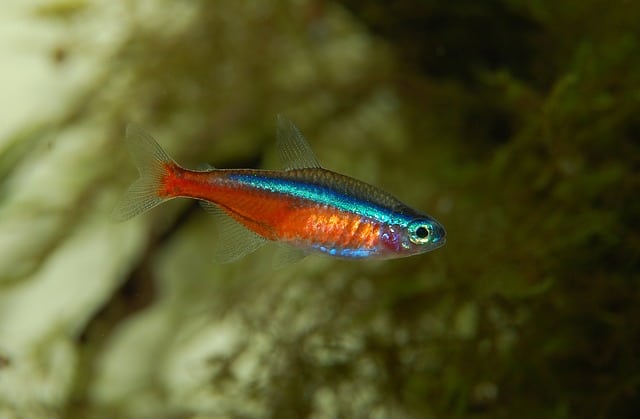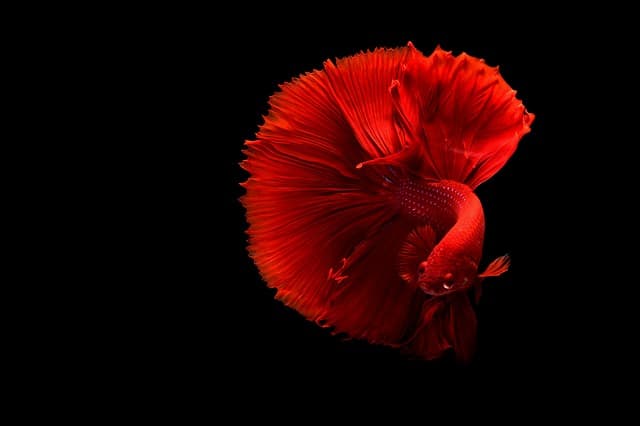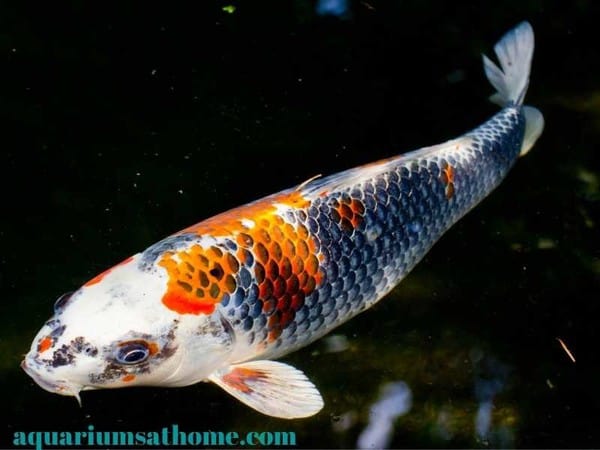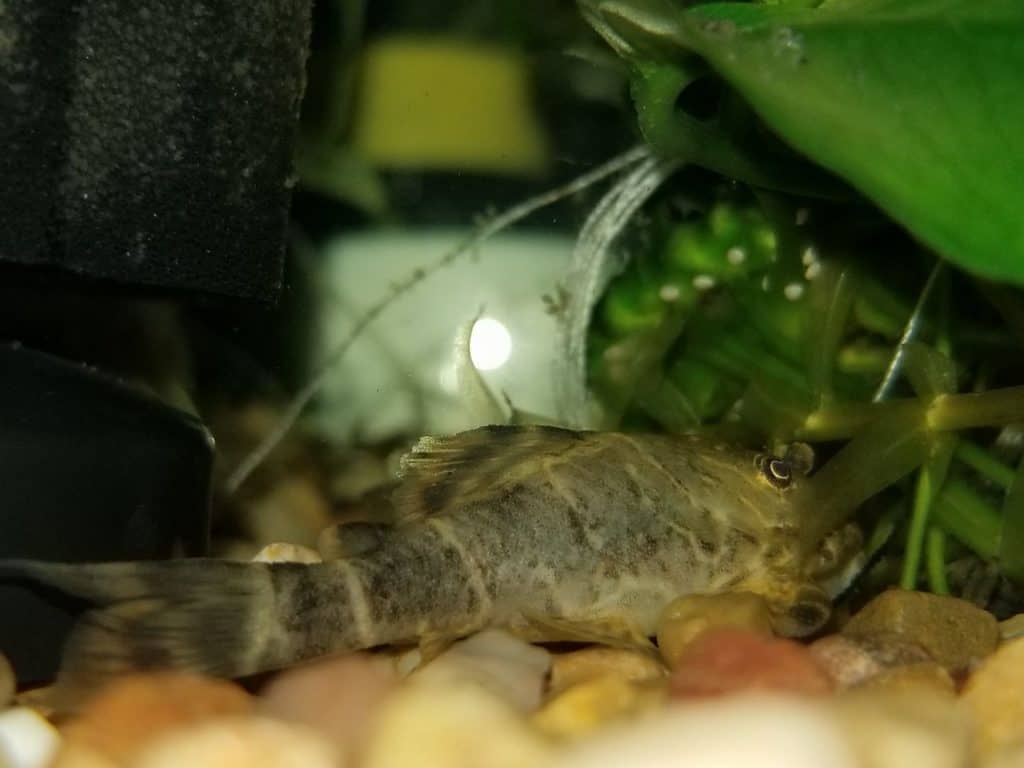Elephant noses are a type of freshwater fish found primarily in the Niger, Chari, and Ogun rivers in Africa. Their unique and intriguing appearance makes them unlike any other and a preferred choice of more experienced aquarists. These fish add life and interest to any freshwater aquarium. They’re also incredibly smart. They can recognize their owners and even be trained to eat right out of your hand!
This article will outline all you need to know as an aquarist about basic elephant nose fish care as well how to maintain, breed, and raise this species in captivity. I’ll also explain how big of a tank they need and how to set it up; what water conditions are required; what to feed them; how long they live and how big they get; what their temperament/behavior is like; how they breed/reproduce; and what (if any) diseases they’re prone to. I’ll discuss some special recommendations for this species as well.
So, if you’re ready to learn more, then let’s ‘dive deeper’ into the aquatic world of the unique and intriguing elephant nose fish…
Elephant Nose Fish Overview
Behavior: semi-aggressive to aggressive
Breeding: not done in captivity
Care level: intermediate to advanced
Diet: carnivore
Family: Mormyridae
Lifespan: 6-10 years
Origin: murky river systems in Africa
Size: 8 to 9 inches long
Reef Safe: N/A – not a saltwater fish
Tank size: 50-gallon minimum
Elephant Nose Fish Natural Habitat
Elephant nose fish are found naturally in the slow-moving, murky rivers of Africa namely the Niger, Chari, and Ogun rivers. Visibility is low in these water systems which is why this species relies on their ‘noses’ or schnauzenorgan as a navigating tool to find food. They use this distinctive feature to navigate their environment, fond food, and detect electromagnetic signals given off by other aquatic creatures.
Elephant Nose Fish Appearance and Size
Elephant nose fish are mainly black or brown in color and look like a cross between an elephant and a swordfish. They have a long, thin body with a few stripes. They don’t have abdominal fins and their pectoral (rear dorsal and anal) fins are the same length. Their most noticeable feature is the trunk-like protrusion on their head which is used for self-defence as well as communication and navigation.
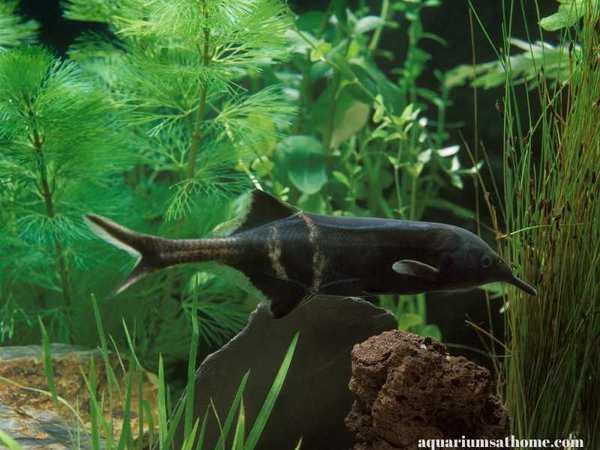
Elephant Nose Fish Behavior and Temperament
Elephant nose fish are usually peaceful in a community tank environment when housed with other species of like size and temperament. However, they often become aggressive and territorial with others of their kind. In the company of other elephant noses, they’ll harass smaller, weaker fish. As bottom-dwellers, they prefer to remain near the substrate and rarely venture higher up in the tank.
Elephant Nose Fish Diet
Elephant nose fish are mainly carnivorous and prefer to eat meaty, protein-rich foods. In the wild, they’ll typically munch on insects and insect larvae. In captivity, they’ll feast on bloodworms and brine shrimp as well as cut up earthworms, black flies, and tubifex (freeze-dried worms). Once they become familiar with their owners, they’ll swim to the surface when they see them and take the food out of their hands!
Elephant Nose Fish Lifespan
Elephant nose fish typically live between 6 to 8 years in captivity. Their lifespan can be increased to 10 years or more with proper care, adequate feedings, and a clean, safe aquatic environment. Regular tank maintenance is a must as well as housing them with peaceful tankmates. They can be quite sensitive to fluctuating water conditions so keeping the parameters adequate and stable is extremely important!
Elephant Nose Fish Aquarium Water Parameters
The required water parameters for elephant nose fish include a temperature between 73- and 83- degrees Fahrenheit with a pH level ranging from 6.5 to 7.2 and a water hardness of 0-10 KH. Keeping their aquatic environment balanced is the key to their overall health and longevity. Investing in a testing kit that measures the pH, ammonia, nitrate, and nitrite levels will help keep their tank clean and safe.
Elephant Nose Fish Tank Requirements (Size and Setup)
Elephant nose fish grow to be quite large (8 to 9 inches long) by aquarium standards and therefore need a big tank. For just a single fish, you’ll need a 50-gallon tank minimum! Bigger is always better when it comes to an aquarium. The more space an elephant nose fish has, the less anxious and/or aggressive it’ll be. If possible, opt for a 60-gallon tank or larger so your elephant nose fish can swim about with ease.
Regarding tank setup, elephant nose fish need very specific water conditions. Maintaining good water quality and keeping the parameters balanced are of the utmost importance which is why investing in a testing kit is a must. See above under the subheading entitled: Elephant Nose Fish Aquarium Water Parameters for more information on water temperature, pH levels, and relative hardness.
Creating an atmosphere as close to the elephant nose fish’s natural habitat is preferred. This species originates in the murky rivers of Africa which is full of plants and debris. Hence, it needs vegetation and driftwood in its tank to navigate around and hide. Including greenery like anubias, hornwort, and/or java moss is recommended. Live plants will also help absorb dangerous nitrogen compounds in the water.
Elephant nose fish are bottom dwellers, so choosing the right substrate is important. They need soft sand that won’t cut or scrape their noses and scales which can lead to an infection. Don’t overcrowd the tank with decorations as this will impeded their ability to swim freely and explore comfortably. As well, make sure not to overcrowd the tank and choose tankmates carefully – see below for more information.
Best Tank Mates for Elephant Nose Fish
The temperament of elephant nose fish is greatly dependent on their tankmates. Species of like size and temperament as well as those that prefer to swim in the upper half of the aquarium are recommended. The ‘top 10’ tankmates for elephant nose fish are angelfish, black ghost knife fish, bichirs, congo tetras, cory catfish, discus fish, dwarf gouramis, honey gouramis, pearl gouramis, and sparkling gouramis.
Breeding Elephant Nose Fish
Breeding elephant nose fish in a contained environment is extremely difficult, mainly because they don’t like to be kept together. And, because it’s almost impossible to sex them, you can’t guarantee getting a male/female pair! This species is typically wild caught and then sold to aquarium hobbyists. There aren’t any up-to-date reports (that I could find) regarding successful breeding of elephant nose fish in captivity.
Types of Elephant Nose Fish
There’s only one species of elephant nose fish, typically referred to as peter’s elephant nose fish, long-nosed elephant fish, elephant fish, or Ubangi mormyrid. They’re also known by their more official term – gnathonemus petersii, named after the person who discovered them. This fish got its name from its long ‘nose’ (which is really an extension of its mouth) that closely resembles that of an elephant’s trunk.
Elephant Nose Fish Cost
Elephant nose fish range in price, depending on the size of the fish as well as where you live. The average cost for a 5-to 7-inch fish is usually between $35 and $50. You can purchase them online through aquarium retailers or at your local pet shop/fish store. It’s recommended that you only buy one per tank as the strongest among them will bully the others if kept together in pairs or groups of 3+.
Common Elephant Nose Fish Diseases
Elephant nose fish aren’t prone to any specific disease. However, this doesn’t mean that they can never get sick. Just like any freshwater aquarium fish, they too can suffer from common illnesses such as ich, fin rot and other parasitic infections. Keeping them healthy and disease-free is directly related to a clean and stable aquatic environment. Regular water testing and bi-weekly partial water changes are a must!
Should the fish fall ill, their heightened sensitivity to changes in water parameters can make it difficult to treat them. Oftentimes, medicating them can make matters worse which is why keeping their tank as clean as possible is very important. Should you have to treat them, it’s better to raise the temperature of the tank to 90-degrees Fahrenheit and add 1 teaspoon (per gallon) of aquarium salt to the water.
One thing to be cautious of with this species is swim bladder disease. Fish use their swim bladders to control their density. Damage to this organ can result in your elephant fish swimming at odd-angles or upside down! Slightly increasing the temperature of the tank by 2 to 3 degrees Fahrenheit for a few days should fix the problem. Once remedied, return the tank to its usual temperature (73- to 83-degrees F).
Special Recommendations for Elephant Nose Fish
Elephant nose fish require a large tank for a single fish – 50 gallons is the minimum. They grow relatively large and need plenty of space to swim, forage, and explore. Since higher stress levels can increase their chances of becoming aggressive or ill, including extra plants (preferably live ones) and a few pieces of driftwood will provide them with the coverage they need to feel safe and ‘at home’ in their aquarium.
Elephant nose fish are very sensitive to changes in their aquatic environment and therefore, need near-perfect water conditions to survive in captivity. Partial water changes (done on a weekly to bi-weekly basis) are required. Using an aquarium vacuum twice a month to clean the substrate is recommended since this species can generate ample amounts of toxic waste.
Are Elephant Nose Fish Hardy?
Under the right tank conditions and with adequate care, elephant nose fish typically do quite well. However, the amount of work required to sustain their aquatic environment is recommended for intermediate to experienced hobbyists rather than beginners. This species is highly sensitive to fluctuations in water parameters and needs a just-right aquarium setup to thrive in captivity.
Pros and Cons of Elephant Nose Fish
Pros
- elephant nose fish are unique in appearance and fun to watch – they’re very active along the substrate and like to spend their time exploring their aquatic surroundings
- elephant nose fish aren’t typically prone to disease but can fall victim to the occasional parasitic infection or swim bladder – both of which are easy to treat
- elephant nose fish are easy to feed and prefer to eat meaty foods like brine shrimp and blood worms – both are inexpensive and readily available at your local fish store
- elephant nose fish are peaceful towards tankmates of like size and temperament – they can live amicably in captivity with many different species of freshwater fish
- elephant nose fish can live up to 10 years in captivity, if properly cared for – they can recognize their owners and even be trained to take food right out their hands
Cons
- elephant nose fish require extra work by way of tank maintenance – regular water testing and bi-weekly partial water changes are necessary
- elephant nose fish are highly sensitive to fluctuations in water conditions – even the slightest change can cause illness (or even death), if not remedied immediately
- elephant nose fish typically grow to be quite large – you must be prepared to upsize your tank (to a 50-gallon version or bigger) once they reach adulthood
- elephant nose fish can’t be kept in pairs or groups – they won’t tolerate others of their kind in the same tank and therefore are next to impossible to breed in captivity
- elephant nose fish are typically wild-caught which makes them more expensive to purchase, even as juveniles – the bigger they are, the more they cost
Final Thoughts
In summation, elephant nose fish (aka peter’s elephant fish or long nose elephant fish) are a species of freshwater fish originating in the muddy, slow-moving rivers of Africa. Nocturnal by nature, they prefer to dwell alone near the bottom of the tank, foraging along the substrate in search of food. Their distinct appearance and unique personality make them a favorite choice among more experienced aquarists.
I trust this article has provided you with all the information you need to keep happy, healthy elephant nose fish in captivity. Thanks for reading and good luck with your aquarium hobby.
Recommended Posts
Pictus Catfish Care and Tank Setup (Tank Mates, Breeding, Behaviour)
Blue Crayfish Care Guide and Tank Setup (Temperament, Tankmates, and Breeding)



